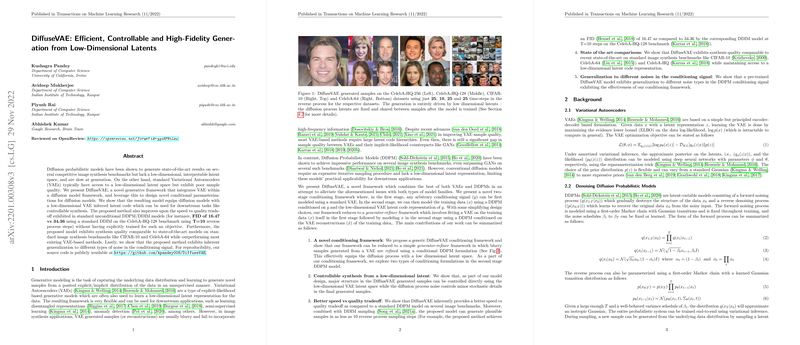An Analysis of "DiffuseVAE: Efficient, Controllable and High-Fidelity Generation from Low-Dimensional Latents"
The paper presents "DiffuseVAE," a sophisticated framework that fuses Variational Autoencoders (VAEs) with Diffusion Probabilistic Models (DDPMs) to address limitations inherent in both model families. This approach effectively combines the strengths of VAEs, which offer a low-dimensional latent space, with the high fidelity sample generation capabilities of diffusion models. The integration is structured to leverage advantages such as reduced generation time and enhanced control over image synthesis while maintaining state-of-the-art quality.
Motivations and Contributions
VAEs are widely recognized for their utility in learning interpretable, low-dimensional representations; however, their output quality often lacks the fine detail associated with competing models like GANs. Conversely, diffusion models are celebrated for their impressive synthesis quality but suffer from slow iterative sampling and a lack of low-dimensional latent representation. The authors propose a two-stage mechanism in "DiffuseVAE" to mitigate these challenges:
- Framework Integration: The paper introduces a novel generator-refiner architecture wherein a VAE first generates a coarse image sample, which is subsequently refined by a conditional DDPM. This conditioning framework endows the diffusion process with a meaningful latent space, facilitating tasks such as controllable synthesis.
- Improved Speed vs. Quality Tradeoff: The paper showcases how DiffuseVAE surpasses traditional DDPM/DDIM models in terms of efficiency, achieving a notable reduction in Fréchet Inception Distance (FID) from 34.36 to 16.47 on the CelebA-HQ-128 benchmark using only 10 reverse-process steps.
- Controllable Synthesis: The framework allows for significant control over generated images via manipulation of the VAE latent space, demonstrated through techniques like attribute editing and interpolation.
- Generalization to Noisy Signals: An intriguing finding is the model's ability to generalize and enhance different noise types in the conditioning signal, highlighting its adaptability in unexpected situations.
Experimental Validation and Results
Extensive experiments validate the framework's capabilities:
- The improvement in speed vs. quality is consistently exemplified across multiple image synthesis benchmarks, maintaining high-fidelity outputs in far fewer steps than required in traditional methods.
- The incorporation of DDIM sampling illustrates the approach's compatibility with recent advancements in diffusion modeling, further optimizing generative efficiency.
Theoretical and Practical Implications
The paper's hypothesis, associating the strong performance of DiffuseVAE with the synergy of VAEs and DDPMs, holds considerable implications:
- Theoretically, it suggests a pathway to overcome traditional limitations of VAE quality through diffusion-based refinement.
- Practically, the advancement in controllable synthesis opens new avenues for applications in areas demanding high degrees of customization, such as personalized media content generation.
Future Directions
Several open questions remain, providing fertile ground for future exploration:
- The gap between DiffuseVAE and the best performing DDPMs at full sampling rates hints at potential enhancements, possibly through more sophisticated priors or other architectural innovations.
- Further investigations into the adaptability of DiffuseVAE for other data modalities such as text or audio could broaden its utility.
In conclusion, this work presents a robust argument for the synergistic convergence of VAEs and DDPMs within a unified framework, achieving strong results in image generation tasks. The successful reduction of generation time while maintaining quality and control marks a significant step forward, setting a promising direction for future research in the field of generative modeling.
